
Steve Miller: A Natural Visionary
By Michelle Trauring
February 18th, 2014
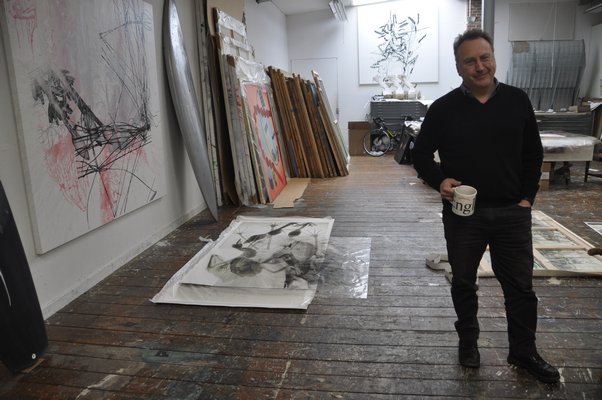 Artist Steve Miller has launched a line of surfboards, clothing and even art books that complement his large-scale work.
Artist Steve Miller has launched a line of surfboards, clothing and even art books that complement his large-scale work.
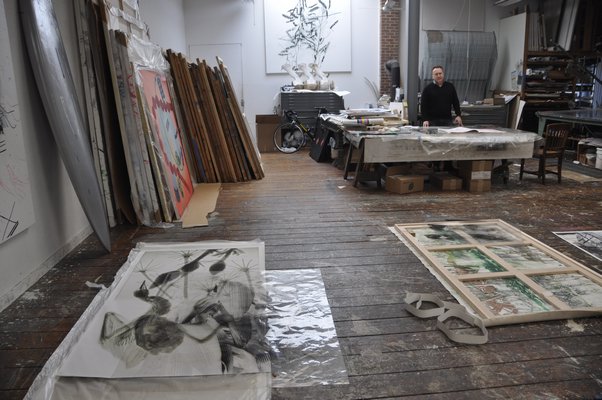
All that artist Steve Miller trusts are his eyes.
What he sees, he believes.
And when he sees a path, he follows it.
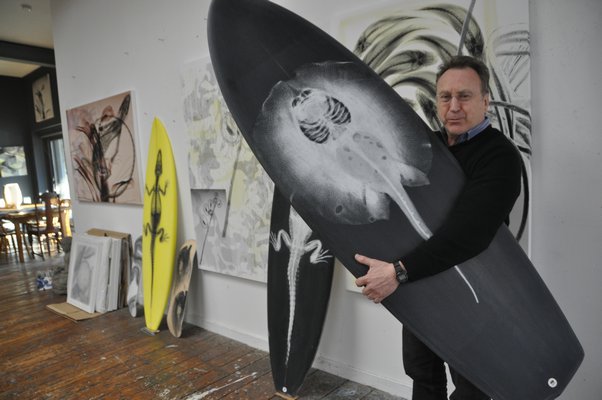
In the 1980s, it was the birth of the computer age. The machines filled an entire room. The internet was a faraway figment. And Mr. Miller was absolutely fascinated, eager to adapt his art to the technology developing right in front of him.
He was an early pioneer of what was eventually coined “SciArt,” or science-based art. And for the past 32 years, Mr. Miller has ex-
plored various topics around the world—including the Amazon rain forest, the folding of proteins, the movement of ions across the cellular membrane, and the human psyche—using electron microscopes, X-rays, MRI machines and Rorschach blots to create drawings, paintings, prints and sculpture that have pushed the boundaries of both modern technology and public taste.
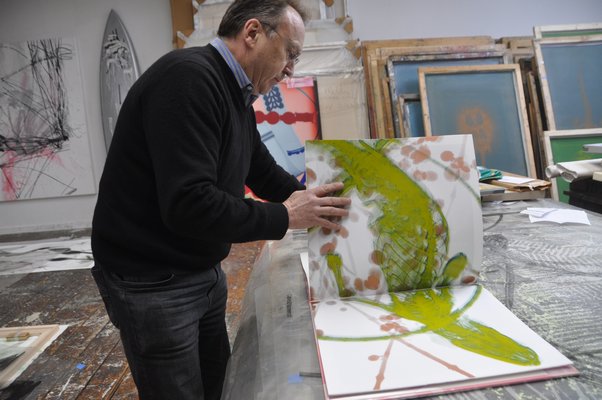
Today, the painter, printmaker and sculptor is breaking down even more walls by diving into the commercial world with a fashion line, one-of-a-kind art books and even surfboards—straddling the line between retail success and staying true to who he is as an artist.
It is a lifelong passion, he explained. As a child growing up in Buffalo, he always had a creative streak. In fact, art was his escape.
The boy was coping with several learning disabilities: a speech impediment, a hearing problem that was eventually corrected and, to make matters worse, his father switched him from left- to right-handedness.
“I was super uncoordinated,” the 62-year-old artist laughed over a mug of Yorkshire Gold tea, sitting in the middle of his spacious, 6,400-square-foot home-studio in Sagaponack. “All that stuff made me the way I am now: more visually attuned. I gotta see it. I know a lot of what you see is an illusion, but my eyes are my teachers. And my eyes are how I learn.”
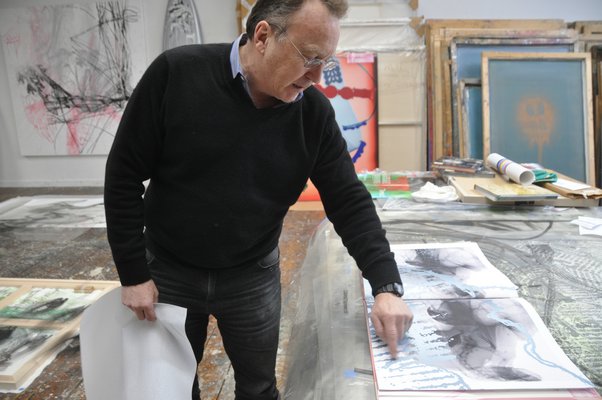
Five years after graduating from Middlebury College in Vermont, and before he eventually settled in his permanent space just north of the highway, the artist found himself renting a dreamy Sagaponack beach house on stilts—no insulation, just wood and studs, he said—during the summer of 1979.
They were the glory days, he said, living and breathing the artistic legacy of the East End.
“It’s, like, your fantasy,” the artist reminisced. “It was really something amazing. And once you connect to that, man, you’re hooked. Forget it. Only rehab is gonna get you out of here.”
Or the colder weather, he added. And lack of space—the beach house’s only major flaw. The large-scale artist couldn’t do any work. So, instead, he read French critical theory.
It flooded his mind with new thoughts and ideas, awakening him to aspects of cultural and technological development that change the nature of society—specifically, computers. At that time, he was immersed in creating “really bad, 27th-generation” abstract expressionism, he said. And he had finally found his way out.
“There was a trail,” the artist said, “and I just started following it. However, to get to a computer, you had to go find one. It wasn’t like you could walk into the store and get a computer. That didn’t happen until the ’90s.”
But once it did, there was no “fire,” Mr. Miller said. Early on, computers were considered a gimmick—“hard to believe, I know,” he said—and, by the transitive property, so was his work. He moved to France, where it was better received, until the United States eventually caught up and on.
“This is the upper urinary tract seen under an electron microscope,” Mr. Miller said, flipping through an early art catalogue of his. “It looks like a brain or coral. You don’t know what you’re looking at, but it’s pure technology. Then I started using Rorschach blots and I realized I could look at what was wrong with society. In those days, they were complete abstractions. Nobody knew what this stuff was when they were looking at it.”
This new visual vocabulary excited the artist, most recently leading him to Brookhaven National Laboratory in Upton to work with Nobel Prize-winning neurobiologist Rod MacKinnon—who won the award for discovering how positively charged ions move across cell membranes in the midst of their collaboration. The resulting exhibition, “Crossing the Line,” recently closed at the National Academy of Sciences museum in Washington, D.C.

Simultaneously, Mr. Miller was also making trips down to Brazil, working on a body of art that he would eventually call “Health of the Planet.” The idea was simple. He would give the Amazon a medical checkup by X-raying plants and animals. The piranhas and stingrays were not alive, he said. But the snake and birds were. As was the alligator. And after developing exposures of a handful of turtles, the artist and an assisting veterinarian were both surprised to see that some of them were pregnant.
This past summer, a clothing and surfboard line featuring the X-ray images was released in South America. The piranha bathing trunks sold out in two weeks, Mr. Miller reported, holding a pair up against his waist.
“If you wear this, you’ve gotta swim quickly,” he said. “The idea of bringing this dialogue of the environment and sustainability onto a commercial product, I find beautiful from a design sense, and more about being aware of the natural world. So I’m trying to use this as a way to get that message out there. But it’s also, like, how cool is this?”
The clothing is reasonably priced—about $60 for a T-shirt, he said—but the surfboards are not. Hand-shaped and individually unique, Mr. Miller imagines they’ll sell for no less than $5,000 each, once imported to the United States.
“They’re made to be used. I would love to see somebody surf one, but I think they’re probably too expensive,” he said. “What I like about these commercial products is that surfing is very much in the soul of Brazil. All the surfers here are always hunting for the right wave. And that’s being a part of nature.”
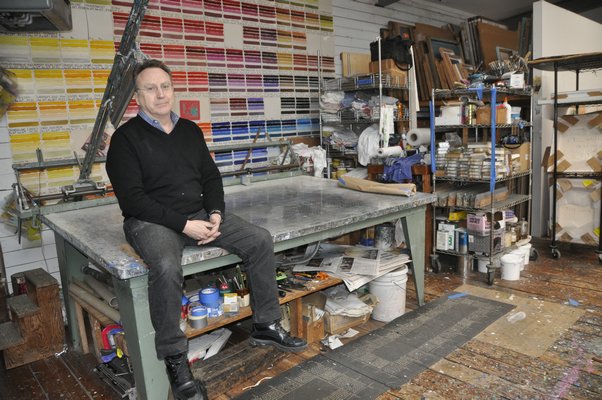
But there is also a dark side, Mr. Miller said, and an inner struggle while walking the line between art and commerce—and keeping the environment in mind. He has learned to adapt, he said, as all artists must in order to survive.
“Getting your signature surfboard, it’s just really fun,” he said. “The clothing line, the surfboard and the images are just like the natural world. But these things are made of petrol chemicals, so the dialogue gets really complex and weird. You can’t be moralistic all the time. All you can do is be aware that we’re all a part of this.”
